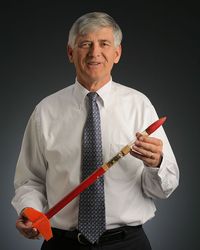Forrest Mims
Forrest M. Mims III is an American writer, amateur scientist, magazine columnist, and author of the popular Getting Started in Electronics and Engineer's Mini-Notebook series of instructional books that was originally sold in Radio Shack electronics stores.
Early life and education
Forrest Mims was born in 1944 in Houston, Texas. His parents were Forrest M. Mims, Jr. (1923–1996), an Air Force pilot, and Ollieve E. (Dunn) Mims (1924–1995). He was the oldest of five children, two boys and three girls. Mims was interested in science at an early age, and he built an analog computer as a high school science fair project in 1960. Mims graduated from Texas A&M University, at the time an all-male military school, in 1966 with a major in government and minors in English and history. He became a commissioned officer in the United States Air Force.
Mims wrote an article for the December 1987 issue of Modern Electronics describing his homebrew analog computer complete with schematics and photographs.[1]
Career in Science
Mims went on to have a successful career as a science author, researcher, lecturer and syndicated columnist. His series of electronics books sold over 7 million copies and he is widely regarded as one of the world's most prolific citizen scientists.[2] Mims does scientific studies in many fields using instruments he designs and makes and he has been published in a number of peer-reviewed journals, often with professional scientists as co-authors. Much of his research deals with ecology and environmental science. A simple instrument he developed to measure the ozone layer earned him a Rolex Award for Enterprise in 1993. In December 2008 Discover magazine named Mims one of the "50 Best Brains in Science."[3] He has invented an atmospheric haze sensor that costs less than $20 and is so simple that even the most hardened technophobe can put it together in under an hour. According Carlson Shawn from Scientifc American, Mims’s instrument could revolutionize this important area of study by opening the field to all-comers, that is, to amateur scientists.[4]
Scientific American magazine
Mims had written some Amateur Scientist columns in Scientific American in 1990. But the Scientific American refused to hire him when they found out that he was a creationist, although they admitted that his work was “fabulous”, “great” and “first rate”,and “should be published somewhere”.[5]
Mr Forrest Mims was asked in 1989 to write three trial articles for Scientific American’s ‘The Amateur Scientist’ column. Mr Mims and the staff at the magazine expected the trial articles to lead to permanent work if they were satisfactory. The three trial articles were published in June, August, and October 1990. After being asked about his opinion about the theory of evolution, Mims said he was a conservative Christian and believed in the biblical account of Genesis. At the same time, a senior editor of the magazine also asked his views on abortion. he was denied future work with the magazine.[6]
Despite the magazine's editor, Jonathan Piel denied in a telephone interview that Mr. Mims had been the victim of religious discrimination, others who worked at the magazine at the time said there had been considerable debate over what to do with Mr. Mims. Mr. Appenzeller, now senior editor at The Sciences magazine, said "I was among those who felt we should have hired him".[7]
References
- ↑ Mims, Forrest (December 1987). "A Homebrew Analog Computer". Modern Electronics 4 (12): 39–41. ISSN 0748-9889.
- ↑ Schlesinger, Victoria (December 2008). "The Amateur Scientists Who Might Cure Cancer—From Their Basements". Discover Magazine. http://discovermagazine.com/2008/dec/19-the-amateur-scientists-who-might-cure-cancer-from-their-basements.
- ↑ Powell, Corey S. (December 2008). "The 50 Most Important, Influential, and Promising People in Science". Discover Magazine: 46. http://discovermagazine.com/2008/dec/19-the-50-most-important-influential-and-promising-people-in-science.
- ↑ "Revolutionary Atmospheric Invention by Victim of Anti-creationist Discrimination". https://creation.com/revolutionary-atmospheric-invention-by-victim-of-anti-creationist-discrimination. Retrieved 10 September 2019.
- ↑ "Revolutionary Atmospheric Invention by Victim of Anti–creationist Discrimination". November 1997. https://answersingenesis.org/creation-vs-evolution/revolutionary-atmospheric-invention-by-anti-creationist-victim/.
- ↑ "Scientific American refuses to hire creationist". https://creation.com/scientific-american-refuses-to-hire-creationist. Retrieved 10 September 2019.
- ↑ "Hire a Creationist? A Nonbeliever in Darwin? Not at a Proud Science Journal". https://www.nytimes.com/1990/10/24/us/hire-a-creationist-a-nonbeliever-in-darwin-not-at-a-proud-science-journal.html. Retrieved 10 September 2019.
